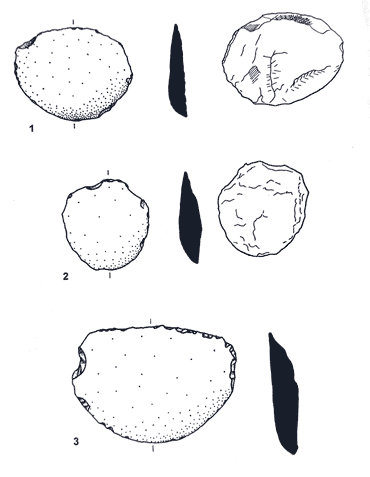Focus on finds: Skaill knives (and how to make them)
in the parish of Sandwick, Orkney, recently excavated (1867)

Not all the stone tools from the Ness of Brodgar are works of exquisite craftsmanship that took patience and skill to fashion. Some are obviously purely functional – none more so than “Skaill knives”.
These are simple, handheld stone “blades” created by striking a flake from a large, rounded, sandstone cobble.

During excavations at Skara Brae in the late 1920s, Gordon Childe found these flakes in such quantities that he named them Skaill knives.
Why?
Because Skara Brae sits on the southern shore of the Bay of Skaill.
The process to create a Skaill knife is very simple.
Throw a suitable beach cobble against another secure stone (but stand back – they can bounce!). The resulting flake has a sharp edge, providing a cutting tool that experimental work has shown to be highly efficient at butchery [1].
It was the Orcadian antiquarian George Petrie who recognised Skaill knives for what they were. In 1867, almost 20 years after Skara Brae was exposed by the elements, Petrie wrote: “There is one type of stone implement very abundant at Skaill.” [2]
These flakes had been:
Petrie added:

Although certain the flakes were not the result of natural attrition, Petrie was perplexed. “The process by which these rude stone implements had been obtained seemed to be still a matter of doubt,” he declared.
The answer came on a visit to Westray, when Petrie witnessed his son hurling beach stones on the rocks. The boy, he realised, had “unwittingly rediscovered the ancient mode of producing the rude stone implements”.
Petrie had been investigating a “kitchen midden” within some “artificial mounds”. Excavating with a pocket-knife, he and a colleague found “great numbers of stone flakes similar to those from Skara”. [2]
The artefacts were clearly on his mind when he later encountered a stone on the beach. It had clearly been broken a few hours earlier, but by natural causes.
Watching the results of his son’s stone-breaking exploits, Petrie had a go himself:
The nature of their fabrication means that Skaill knives can vary in size, with their shape dictated by that of their “parent” cobble.

Few excavated examples show evidence of reworking – it seems they were used until the sharp edge dulled, or was damaged, and then thrown away.

As mentioned previously, it seems likely that Skaill knives primary role related to butchery. Evidence gathered by lithics specialist Ann Clarke has shown that, for this purpose, they were extremely efficient:
Further Reading
- Skaill knives – Working Stone.
- Stone tools and Butchering by Ann Clarke, Lithic Specialist
- The Skaill Knife as a butchering tool, by Ann Clarke (PDF)
- A decorated Skaill knife from Skara Brae, Orkney, by Alan Saville (PDF)
Notes
- [1] Clarke, A. (2006) Stone tools and the Prehistory of the Northern Isles (Vol. 406). British Archaeological Reports Limited.
- [2] Petrie, G. (1867) Notice of ruins of ancient dwellings at Skara, Bay of Skaill, in the Parish of Sandwick, Orkney, recently excavated. In Proceedings of the Society of Antiquaries of Scotland (Vol. 7, pp. 201-219).














